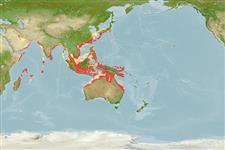Common names from other countries
Environment: milieu / climate zone / depth range / distribution range
Ecologie
marien; brak water demersaal; diepte 0 - 60 m (Ref. 9804). Tropical; 20°C - 30°C (Ref. 13614); 37°N - 28°S, 48°E - 154°E
Indo-West Pacific: Red Sea (Ref. 130655), the Persian Gulf, Gulf of Oman, Arabian Sea, Bay of Bengal, and Japan (north to central Honshu), China, South China Sea including Gulf of Thailand, Indonesia, northern Australia.
Grootte / Gewicht / Leeftijd
Maturity: Lm ? range ? - ? cm
Max length : 30.0 cm TL mannelijk / geslacht onbekend; (Ref. 9804); common length : 25.0 cm TL mannelijk / geslacht onbekend; (Ref. 3540)
Spiny dorsal-fin membrane very dark between first and third spines, and usually equally dark between third and fifth spines. Outline of head from base of first dorsal-fin spine to above eye an even slightly convex curve or almost a straight line (Ref 9804).
Inhabits sandy or muddy flat in coastal and estuarine waters. Feeds on benthic invertebrates. Sold fresh in markets. Used in Chinese medicine (Ref. 12166). Minimum depth range from Ref. 121772.
Levenscyclus en paargedrag
Maturities | Voortplanting | Spawnings | Egg(s) | Fecundities | Larven
Matsuura, K., 2001. Triacanthidae. Triplespines. p. 3905-3910. In K.E. Carpenter and V. Niem (eds.) FAO species identification guide for fishery purposes. The living marine resources of the Western Central Pacific. Vol. 6. Bony fishes part 4 (Labridae to Latimeriidae), estuarine crocodiles. FAO, Rome. (Ref. 9804)
Status op de Rode Lijst van het IUCN (Ref. 130435)
CITES (Ref. 128078)
Not Evaluated
Gevaar voor de mens
Harmless
Gebruik door de mens
Visserij: van minder commercieel belang
Tools
Speciale rapporten
Download XML
Internetbronnen
Estimates based on models
Preferred temperature (Ref.
115969): 24.6 - 29.1, mean 28.2 (based on 1448 cells).
Fylogenetische diversiteitsindex (Ref.
82804): PD
50 = 0.7578 [Uniqueness, from 0.5 = low to 2.0 = high].
Bayesian length-weight: a=0.01072 (0.00523 - 0.02196), b=2.87 (2.68 - 3.06), in cm Total Length, based on LWR estimates for this species & (Sub)family-body (Ref.
93245).
Trofisch niveau (Ref.
69278): 2.8 ±0.29 se; based on food items.
Weerstandsvermogen (Ref.
120179): Gemiddeld, minimale populatieverdubbelingstijd 1,4-4,4 jaar (K=0.22).
Fishing Vulnerability (Ref.
59153): Moderate vulnerability (40 of 100).
